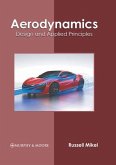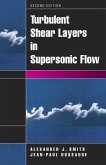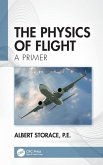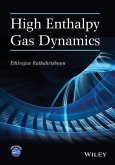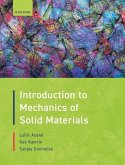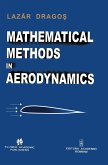Craig A Kluever
Space Flight Dynamics
Herausgeber: Belobaba, Peter; Seabridge, Allan; Cooper, Jonathan
Craig A Kluever
Space Flight Dynamics
Herausgeber: Belobaba, Peter; Seabridge, Allan; Cooper, Jonathan
- Gebundenes Buch
- Merkliste
- Auf die Merkliste
- Bewerten Bewerten
- Teilen
- Produkt teilen
- Produkterinnerung
- Produkterinnerung
Thorough coverage of space flight topics with self-contained chapters serving a variety of courses in orbital mechanics, spacecraft dynamics, and astronautics This concise yet comprehensive book on space flight dynamics addresses all phases of a space mission: getting to space (launch trajectories), satellite motion in space (orbital motion, orbit transfers, attitude dynamics), and returning from space (entry flight mechanics). It focuses on orbital mechanics with emphasis on two-body motion, orbit determination, and orbital maneuvers with applications in Earth-centered missions and…mehr
Andere Kunden interessierten sich auch für
![Hypersonic and Supersonic Flight - Advances in Aerodynamics, Materials, and Vehicle Design Hypersonic and Supersonic Flight - Advances in Aerodynamics, Materials, and Vehicle Design]() Hypersonic and Supersonic Flight - Advances in Aerodynamics, Materials, and Vehicle Design138,99 €
Hypersonic and Supersonic Flight - Advances in Aerodynamics, Materials, and Vehicle Design138,99 €![Aerodynamics: Design and Applied Principles Aerodynamics: Design and Applied Principles]() Aerodynamics: Design and Applied Principles162,99 €
Aerodynamics: Design and Applied Principles162,99 €![Turbulent Shear Layers in Supersonic Flow Turbulent Shear Layers in Supersonic Flow]() Alexander J. SmitsTurbulent Shear Layers in Supersonic Flow161,99 €
Alexander J. SmitsTurbulent Shear Layers in Supersonic Flow161,99 €![The Physics of Flight The Physics of Flight]() Albert StoraceThe Physics of Flight129,99 €
Albert StoraceThe Physics of Flight129,99 €![High Enthalpy Gas Dynamics High Enthalpy Gas Dynamics]() Ethirajan RathakrishnanHigh Enthalpy Gas Dynamics179,99 €
Ethirajan RathakrishnanHigh Enthalpy Gas Dynamics179,99 €![Introduction to Mechanics of Solid Materials Introduction to Mechanics of Solid Materials]() Lallit AnandIntroduction to Mechanics of Solid Materials141,99 €
Lallit AnandIntroduction to Mechanics of Solid Materials141,99 €![Mathematical Methods in Aerodynamics Mathematical Methods in Aerodynamics]() Lazãr DragosMathematical Methods in Aerodynamics248,99 €
Lazãr DragosMathematical Methods in Aerodynamics248,99 €-
-
-
Thorough coverage of space flight topics with self-contained chapters serving a variety of courses in orbital mechanics, spacecraft dynamics, and astronautics This concise yet comprehensive book on space flight dynamics addresses all phases of a space mission: getting to space (launch trajectories), satellite motion in space (orbital motion, orbit transfers, attitude dynamics), and returning from space (entry flight mechanics). It focuses on orbital mechanics with emphasis on two-body motion, orbit determination, and orbital maneuvers with applications in Earth-centered missions and interplanetary missions. Space Flight Dynamics presents wide-ranging information on a host of topics not always covered in competing books. It discusses relative motion, entry flight mechanics, low-thrust transfers, rocket propulsion fundamentals, attitude dynamics, and attitude control. The book is filled with illustrated concepts and real-world examples drawn from the space industry. Additionally, the book includes a "computational toolbox" composed of MATLAB M-files for performing space mission analysis. Key features: * Provides practical, real-world examples illustrating key concepts throughout the book * Accompanied by a website containing MATLAB M-files for conducting space mission analysis * Presents numerous space flight topics absent in competing titles Space Flight Dynamics is a welcome addition to the field, ideally suited for upper-level undergraduate and graduate students studying aerospace engineering.
Hinweis: Dieser Artikel kann nur an eine deutsche Lieferadresse ausgeliefert werden.
Hinweis: Dieser Artikel kann nur an eine deutsche Lieferadresse ausgeliefert werden.
Produktdetails
- Produktdetails
- Verlag: Wiley
- 2nd edition
- Seitenzahl: 592
- Erscheinungstermin: 29. Mai 2018
- Englisch
- Abmessung: 250mm x 175mm x 36mm
- Gewicht: 1172g
- ISBN-13: 9781119157823
- ISBN-10: 111915782X
- Artikelnr.: 51762333
- Herstellerkennzeichnung
- Libri GmbH
- Europaallee 1
- 36244 Bad Hersfeld
- 06621 890
- Verlag: Wiley
- 2nd edition
- Seitenzahl: 592
- Erscheinungstermin: 29. Mai 2018
- Englisch
- Abmessung: 250mm x 175mm x 36mm
- Gewicht: 1172g
- ISBN-13: 9781119157823
- ISBN-10: 111915782X
- Artikelnr.: 51762333
- Herstellerkennzeichnung
- Libri GmbH
- Europaallee 1
- 36244 Bad Hersfeld
- 06621 890
Craig A. Kluever is C. W. LaPierre Professor of Mechanical and Aerospace Engineering, University of Missouri-Columbia, USA. He has industry experience as an aerospace engineer on the Space Shuttle program and has performed extensive research at the University of Missouri in collaboration with NASA involving trajectory optimization, space mission design, entry flight mechanics, and guidance and control of aerospace vehicles.
Preface xi
1 Historical Overview 1
1.1 Introduction 1
1.2 Early Modern Period 1
1.3 Early Twentieth Century 3
1.4 Space Age 4
2 Two-Body Orbital Mechanics 7
2.1 Introduction 7
2.2 Two-Body Problem 7
2.3 Constants of Motion 11
2.3.1 Conservation of Angular Momentum 11
2.3.2 Conservation of Energy 13
2.4 Conic Sections 15
2.4.1 Trajectory Equation 15
2.4.2 Eccentricity Vector 20
2.4.3 Energy and Semimajor Axis 21
2.5 Elliptical Orbit 23
2.5.1 Ellipse Geometry 24
2.5.2 Flight-Path Angle and Velocity Components 24
2.5.3 Period of an Elliptical Orbit 31
2.5.4 Circular Orbit 32
2.5.5 Geocentric Orbits 33
2.6 Parabolic Trajectory 38
2.7 Hyperbolic Trajectory 42
2.8 Summary 46
Further Reading 46
Problems 47
3 Orbit Determination 55
3.1 Introduction 55
3.2 Coordinate Systems 55
3.3 Classical Orbital Elements 57
3.4 Transforming Cartesian Coordinates to Orbital Elements 60
3.5 Transforming Orbital Elements to Cartesian Coordinates 66
3.5.1 Coordinate Transformations 68
3.6 Ground Tracks 75
3.7 Orbit Determination from One Ground-Based Observation 79
3.7.1 Topocentric-Horizon Coordinate System 79
3.7.2 Inertial Position Vector 81
3.7.3 Inertial Velocity Vector 82
3.7.4 Ellipsoidal Earth Model 85
3.8 Orbit Determination from Three Position Vectors 88
3.9 Survey of Orbit-Determination Methods 95
3.9.1 Orbit Determination Using Angles-Only Measurements 95
3.9.2 Orbit Determination Using Three Position Vectors 97
3.9.3 Orbit Determination from Two Position Vectors and Time 97
3.9.4 Statistical Orbit Determination 98
3.10 Summary 99
References 100
Problems 100
4 Time of Flight 107
4.1 Introduction 107
4.2 Kepler's Equation 107
4.2.1 Time of Flight Using Geometric Methods 107
4.2.2 Time of Flight Using Analytical Methods 108
4.2.3 Relating Eccentric and True Anomalies 112
4.3 Parabolic and Hyperbolic Time of Flight 117
4.3.1 Parabolic Trajectory Flight Time 117
4.3.2 Hyperbolic Trajectory Flight Time 119
4.4 Kepler's Problem 123
4.5 Orbit Propagation Using Lagrangian Coefficients 127
4.6 Lambert's Problem 135
4.7 Summary 145
References 145
Problems 146
5 Non-Keplerian Motion 151
5.1 Introduction 151
5.2 Special Perturbation Methods 152
5.2.1 Non-Spherical Central Body 153
5.3 General Perturbation Methods 159
5.3.1 Lagrange's Variation of Parameters 160
5.3.2 Secular Perturbations due to Oblateness ( J2) 164
5.4 Gauss' Variation of Parameters 174
5.5 Perturbation Accelerations for Earth Satellites 180
5.5.1 Non-Spherical Earth 180
5.5.2 Third-Body Gravity 182
5.5.3 Atmospheric Drag 185
5.5.4 Solar Radiation Pressure 189
5.6 Circular Restricted Three-Body Problem 192
5.6.1 Jacobi's Integral 194
5.6.2 Lagrangian Points 195
5.7 Summary 203
References 203
Problems 204
6 Rocket Performance 213
6.1 Introduction 213
6.2 Rocket Propulsion Fundamentals 213
6.3 The Rocket Equation 214
6.4 Launch Trajectories 219
6.5 Staging 226
6.6 Launch Vehicle Performance 231
6.7 Impulsive Maneuvers 233
6.8 Summary 234
References 235
Problems 235
7 Impulsive Orbital Maneuvers 241
7.1 Introduction 241
7.2 Orbit Shaping 242
7.3 Hohmann Transfer 245
7.3.1 Coplanar Transfer with Tangential Impulses 248
7.4 General Coplanar Transfer 252
7.5 Inclination-Change Maneuver 256
7.6 Three-Dimensional Orbit Transfer 259
7.7 Summary 264
References 264
Problems 264
8 Relative Motion and Orbital Rendezvous 275
8.1 Introduction 275
8.2 Linear Clohessy-Wiltshire Equations 275
8.3 Homogeneous Solution of the Clohessy-Wiltshire Equations 280
8.4 Orbital Rendezvous Using the Clohessy-Wiltshire Equations 288
8.5 Summary 298
References 298
Problems 298
9 Low-Thrust Transfers 303
9.1 Introduction 303
9.2 Electric Propulsion Fundamentals 304
9.3 Coplanar Circle-to-Circle Transfer 306
9.3.1 Comparing Impulsive and Low-Thrust Transfers 313
9.4 Coplanar Transfer with Earth-Shadow Effects 315
9.5 Inclination-Change Maneuver 318
9.6 Transfer Between Inclined Circular Orbits 320
9.7 Combined Chemical-Electric Propulsion Transfer 322
9.8 Low-Thrust Transfer Issues 328
9.9 Summary 329
References 329
Problems 330
10 Interplanetary Trajectories 335
10.1 Introduction 335
10.2 Patched-Conic Method 338
10.2.1 Sphere of Influence 339
10.2.2 Coplanar Heliocentric Transfers between Circular Orbits 341
10.3 Phase Angle at Departure 351
10.4 Planetary Arrival 355
10.5 Heliocentric Transfers Using an Accurate Ephemeris 359
10.5.1 Pork-Chop Plots 367
10.5.2 Julian Date 368
10.6 Gravity Assists 370
10.7 Summary 378
References 379
Problems 379
11 Atmospheric Entry 385
11.1 Introduction 385
11.2 Entry Flight Mechanics 386
11.3 Ballistic Entry 390
11.4 Gliding Entry 396
11.5 Skip Entry 404
11.6 Entry Heating 412
11.7 Space Shuttle Entry 418
11.8 Summary 422
References 423
Problems 423
12 Attitude Dynamics 429
12.1 Introduction 429
12.2 Rigid Body Dynamics 430
12.2.1 Angular Momentum of a Rigid Body 432
12.2.2 Principal Axes 438
12.2.3 Rotational Kinetic Energy 439
12.2.4 Euler's Moment Equations 441
12.3 Torque-Free Motion 442
12.3.1 Euler Angle Rates 447
12.4 Stability and Flexible Bodies 457
12.4.1 Spin Stability about the Principal Axes 457
12.4.2 Stability of Flexible Bodies 459
12.5 Spin Stabilization 464
12.5.1 Dual-Spin Stabilization 466
12.6 Disturbance Torques 467
12.6.1 Gravity-Gradient torque 467
12.6.2 Aerodynamic Torque 468
12.6.3 Solar Radiation Pressure Torque 469
12.6.4 Magnetic Torque 470
12.7 Gravity-Gradient Stabilization 470
12.8 Summary 476
References 477
Problems 477
13 Attitude Control 485
13.1 Introduction 485
13.2 Feedback Control Systems 485
13.2.1 Transfer Functions 486
13.2.2 Closed-Loop Control Systems 489
13.2.3 Second-Order System Response 490
13.3 Mechanisms for Attitude Control 497
13.3.1 Reaction Jets 497
13.3.2 Momentum-Exchange Devices 497
13.3.3 Magnetic Torquers 501
13.4 Attitude Maneuvers Using Reaction Wheels 501
13.5 Attitude Maneuvers Using Reaction Jets 513
13.5.1 Phase-Plane Analysis of Satellite Attitude Dynamics 513
13.5.2 Reaction Jet Control Law 518
13.6 Nutation Control Using Reaction Jets 527
13.7 Summary 534
References 535
Further Reading 535
Problems 535
Appendix A: Physical Constants 541
Appendix B: Review of Vectors 543
B.1 Introduction 543
B.2 Vectors 543
B.3 Vector Operations 544
B.3.1 Vector Addition 544
B.3.2 Cross Product 545
B.3.3 Dot Product 546
B.3.4 Scalar Triple Product 547
B.3.5 Vector Triple Product 547
Appendix C: Review of Particle Kinematics 549
C.1 Introduction 549
C.2 Cartesian Coordinates 549
C.3 Polar Coordinates 551
C.4 Normal-Tangential Coordinates 552
Index
1 Historical Overview 1
1.1 Introduction 1
1.2 Early Modern Period 1
1.3 Early Twentieth Century 3
1.4 Space Age 4
2 Two-Body Orbital Mechanics 7
2.1 Introduction 7
2.2 Two-Body Problem 7
2.3 Constants of Motion 11
2.3.1 Conservation of Angular Momentum 11
2.3.2 Conservation of Energy 13
2.4 Conic Sections 15
2.4.1 Trajectory Equation 15
2.4.2 Eccentricity Vector 20
2.4.3 Energy and Semimajor Axis 21
2.5 Elliptical Orbit 23
2.5.1 Ellipse Geometry 24
2.5.2 Flight-Path Angle and Velocity Components 24
2.5.3 Period of an Elliptical Orbit 31
2.5.4 Circular Orbit 32
2.5.5 Geocentric Orbits 33
2.6 Parabolic Trajectory 38
2.7 Hyperbolic Trajectory 42
2.8 Summary 46
Further Reading 46
Problems 47
3 Orbit Determination 55
3.1 Introduction 55
3.2 Coordinate Systems 55
3.3 Classical Orbital Elements 57
3.4 Transforming Cartesian Coordinates to Orbital Elements 60
3.5 Transforming Orbital Elements to Cartesian Coordinates 66
3.5.1 Coordinate Transformations 68
3.6 Ground Tracks 75
3.7 Orbit Determination from One Ground-Based Observation 79
3.7.1 Topocentric-Horizon Coordinate System 79
3.7.2 Inertial Position Vector 81
3.7.3 Inertial Velocity Vector 82
3.7.4 Ellipsoidal Earth Model 85
3.8 Orbit Determination from Three Position Vectors 88
3.9 Survey of Orbit-Determination Methods 95
3.9.1 Orbit Determination Using Angles-Only Measurements 95
3.9.2 Orbit Determination Using Three Position Vectors 97
3.9.3 Orbit Determination from Two Position Vectors and Time 97
3.9.4 Statistical Orbit Determination 98
3.10 Summary 99
References 100
Problems 100
4 Time of Flight 107
4.1 Introduction 107
4.2 Kepler's Equation 107
4.2.1 Time of Flight Using Geometric Methods 107
4.2.2 Time of Flight Using Analytical Methods 108
4.2.3 Relating Eccentric and True Anomalies 112
4.3 Parabolic and Hyperbolic Time of Flight 117
4.3.1 Parabolic Trajectory Flight Time 117
4.3.2 Hyperbolic Trajectory Flight Time 119
4.4 Kepler's Problem 123
4.5 Orbit Propagation Using Lagrangian Coefficients 127
4.6 Lambert's Problem 135
4.7 Summary 145
References 145
Problems 146
5 Non-Keplerian Motion 151
5.1 Introduction 151
5.2 Special Perturbation Methods 152
5.2.1 Non-Spherical Central Body 153
5.3 General Perturbation Methods 159
5.3.1 Lagrange's Variation of Parameters 160
5.3.2 Secular Perturbations due to Oblateness ( J2) 164
5.4 Gauss' Variation of Parameters 174
5.5 Perturbation Accelerations for Earth Satellites 180
5.5.1 Non-Spherical Earth 180
5.5.2 Third-Body Gravity 182
5.5.3 Atmospheric Drag 185
5.5.4 Solar Radiation Pressure 189
5.6 Circular Restricted Three-Body Problem 192
5.6.1 Jacobi's Integral 194
5.6.2 Lagrangian Points 195
5.7 Summary 203
References 203
Problems 204
6 Rocket Performance 213
6.1 Introduction 213
6.2 Rocket Propulsion Fundamentals 213
6.3 The Rocket Equation 214
6.4 Launch Trajectories 219
6.5 Staging 226
6.6 Launch Vehicle Performance 231
6.7 Impulsive Maneuvers 233
6.8 Summary 234
References 235
Problems 235
7 Impulsive Orbital Maneuvers 241
7.1 Introduction 241
7.2 Orbit Shaping 242
7.3 Hohmann Transfer 245
7.3.1 Coplanar Transfer with Tangential Impulses 248
7.4 General Coplanar Transfer 252
7.5 Inclination-Change Maneuver 256
7.6 Three-Dimensional Orbit Transfer 259
7.7 Summary 264
References 264
Problems 264
8 Relative Motion and Orbital Rendezvous 275
8.1 Introduction 275
8.2 Linear Clohessy-Wiltshire Equations 275
8.3 Homogeneous Solution of the Clohessy-Wiltshire Equations 280
8.4 Orbital Rendezvous Using the Clohessy-Wiltshire Equations 288
8.5 Summary 298
References 298
Problems 298
9 Low-Thrust Transfers 303
9.1 Introduction 303
9.2 Electric Propulsion Fundamentals 304
9.3 Coplanar Circle-to-Circle Transfer 306
9.3.1 Comparing Impulsive and Low-Thrust Transfers 313
9.4 Coplanar Transfer with Earth-Shadow Effects 315
9.5 Inclination-Change Maneuver 318
9.6 Transfer Between Inclined Circular Orbits 320
9.7 Combined Chemical-Electric Propulsion Transfer 322
9.8 Low-Thrust Transfer Issues 328
9.9 Summary 329
References 329
Problems 330
10 Interplanetary Trajectories 335
10.1 Introduction 335
10.2 Patched-Conic Method 338
10.2.1 Sphere of Influence 339
10.2.2 Coplanar Heliocentric Transfers between Circular Orbits 341
10.3 Phase Angle at Departure 351
10.4 Planetary Arrival 355
10.5 Heliocentric Transfers Using an Accurate Ephemeris 359
10.5.1 Pork-Chop Plots 367
10.5.2 Julian Date 368
10.6 Gravity Assists 370
10.7 Summary 378
References 379
Problems 379
11 Atmospheric Entry 385
11.1 Introduction 385
11.2 Entry Flight Mechanics 386
11.3 Ballistic Entry 390
11.4 Gliding Entry 396
11.5 Skip Entry 404
11.6 Entry Heating 412
11.7 Space Shuttle Entry 418
11.8 Summary 422
References 423
Problems 423
12 Attitude Dynamics 429
12.1 Introduction 429
12.2 Rigid Body Dynamics 430
12.2.1 Angular Momentum of a Rigid Body 432
12.2.2 Principal Axes 438
12.2.3 Rotational Kinetic Energy 439
12.2.4 Euler's Moment Equations 441
12.3 Torque-Free Motion 442
12.3.1 Euler Angle Rates 447
12.4 Stability and Flexible Bodies 457
12.4.1 Spin Stability about the Principal Axes 457
12.4.2 Stability of Flexible Bodies 459
12.5 Spin Stabilization 464
12.5.1 Dual-Spin Stabilization 466
12.6 Disturbance Torques 467
12.6.1 Gravity-Gradient torque 467
12.6.2 Aerodynamic Torque 468
12.6.3 Solar Radiation Pressure Torque 469
12.6.4 Magnetic Torque 470
12.7 Gravity-Gradient Stabilization 470
12.8 Summary 476
References 477
Problems 477
13 Attitude Control 485
13.1 Introduction 485
13.2 Feedback Control Systems 485
13.2.1 Transfer Functions 486
13.2.2 Closed-Loop Control Systems 489
13.2.3 Second-Order System Response 490
13.3 Mechanisms for Attitude Control 497
13.3.1 Reaction Jets 497
13.3.2 Momentum-Exchange Devices 497
13.3.3 Magnetic Torquers 501
13.4 Attitude Maneuvers Using Reaction Wheels 501
13.5 Attitude Maneuvers Using Reaction Jets 513
13.5.1 Phase-Plane Analysis of Satellite Attitude Dynamics 513
13.5.2 Reaction Jet Control Law 518
13.6 Nutation Control Using Reaction Jets 527
13.7 Summary 534
References 535
Further Reading 535
Problems 535
Appendix A: Physical Constants 541
Appendix B: Review of Vectors 543
B.1 Introduction 543
B.2 Vectors 543
B.3 Vector Operations 544
B.3.1 Vector Addition 544
B.3.2 Cross Product 545
B.3.3 Dot Product 546
B.3.4 Scalar Triple Product 547
B.3.5 Vector Triple Product 547
Appendix C: Review of Particle Kinematics 549
C.1 Introduction 549
C.2 Cartesian Coordinates 549
C.3 Polar Coordinates 551
C.4 Normal-Tangential Coordinates 552
Index
Preface xi
1 Historical Overview 1
1.1 Introduction 1
1.2 Early Modern Period 1
1.3 Early Twentieth Century 3
1.4 Space Age 4
2 Two-Body Orbital Mechanics 7
2.1 Introduction 7
2.2 Two-Body Problem 7
2.3 Constants of Motion 11
2.3.1 Conservation of Angular Momentum 11
2.3.2 Conservation of Energy 13
2.4 Conic Sections 15
2.4.1 Trajectory Equation 15
2.4.2 Eccentricity Vector 20
2.4.3 Energy and Semimajor Axis 21
2.5 Elliptical Orbit 23
2.5.1 Ellipse Geometry 24
2.5.2 Flight-Path Angle and Velocity Components 24
2.5.3 Period of an Elliptical Orbit 31
2.5.4 Circular Orbit 32
2.5.5 Geocentric Orbits 33
2.6 Parabolic Trajectory 38
2.7 Hyperbolic Trajectory 42
2.8 Summary 46
Further Reading 46
Problems 47
3 Orbit Determination 55
3.1 Introduction 55
3.2 Coordinate Systems 55
3.3 Classical Orbital Elements 57
3.4 Transforming Cartesian Coordinates to Orbital Elements 60
3.5 Transforming Orbital Elements to Cartesian Coordinates 66
3.5.1 Coordinate Transformations 68
3.6 Ground Tracks 75
3.7 Orbit Determination from One Ground-Based Observation 79
3.7.1 Topocentric-Horizon Coordinate System 79
3.7.2 Inertial Position Vector 81
3.7.3 Inertial Velocity Vector 82
3.7.4 Ellipsoidal Earth Model 85
3.8 Orbit Determination from Three Position Vectors 88
3.9 Survey of Orbit-Determination Methods 95
3.9.1 Orbit Determination Using Angles-Only Measurements 95
3.9.2 Orbit Determination Using Three Position Vectors 97
3.9.3 Orbit Determination from Two Position Vectors and Time 97
3.9.4 Statistical Orbit Determination 98
3.10 Summary 99
References 100
Problems 100
4 Time of Flight 107
4.1 Introduction 107
4.2 Kepler's Equation 107
4.2.1 Time of Flight Using Geometric Methods 107
4.2.2 Time of Flight Using Analytical Methods 108
4.2.3 Relating Eccentric and True Anomalies 112
4.3 Parabolic and Hyperbolic Time of Flight 117
4.3.1 Parabolic Trajectory Flight Time 117
4.3.2 Hyperbolic Trajectory Flight Time 119
4.4 Kepler's Problem 123
4.5 Orbit Propagation Using Lagrangian Coefficients 127
4.6 Lambert's Problem 135
4.7 Summary 145
References 145
Problems 146
5 Non-Keplerian Motion 151
5.1 Introduction 151
5.2 Special Perturbation Methods 152
5.2.1 Non-Spherical Central Body 153
5.3 General Perturbation Methods 159
5.3.1 Lagrange's Variation of Parameters 160
5.3.2 Secular Perturbations due to Oblateness ( J2) 164
5.4 Gauss' Variation of Parameters 174
5.5 Perturbation Accelerations for Earth Satellites 180
5.5.1 Non-Spherical Earth 180
5.5.2 Third-Body Gravity 182
5.5.3 Atmospheric Drag 185
5.5.4 Solar Radiation Pressure 189
5.6 Circular Restricted Three-Body Problem 192
5.6.1 Jacobi's Integral 194
5.6.2 Lagrangian Points 195
5.7 Summary 203
References 203
Problems 204
6 Rocket Performance 213
6.1 Introduction 213
6.2 Rocket Propulsion Fundamentals 213
6.3 The Rocket Equation 214
6.4 Launch Trajectories 219
6.5 Staging 226
6.6 Launch Vehicle Performance 231
6.7 Impulsive Maneuvers 233
6.8 Summary 234
References 235
Problems 235
7 Impulsive Orbital Maneuvers 241
7.1 Introduction 241
7.2 Orbit Shaping 242
7.3 Hohmann Transfer 245
7.3.1 Coplanar Transfer with Tangential Impulses 248
7.4 General Coplanar Transfer 252
7.5 Inclination-Change Maneuver 256
7.6 Three-Dimensional Orbit Transfer 259
7.7 Summary 264
References 264
Problems 264
8 Relative Motion and Orbital Rendezvous 275
8.1 Introduction 275
8.2 Linear Clohessy-Wiltshire Equations 275
8.3 Homogeneous Solution of the Clohessy-Wiltshire Equations 280
8.4 Orbital Rendezvous Using the Clohessy-Wiltshire Equations 288
8.5 Summary 298
References 298
Problems 298
9 Low-Thrust Transfers 303
9.1 Introduction 303
9.2 Electric Propulsion Fundamentals 304
9.3 Coplanar Circle-to-Circle Transfer 306
9.3.1 Comparing Impulsive and Low-Thrust Transfers 313
9.4 Coplanar Transfer with Earth-Shadow Effects 315
9.5 Inclination-Change Maneuver 318
9.6 Transfer Between Inclined Circular Orbits 320
9.7 Combined Chemical-Electric Propulsion Transfer 322
9.8 Low-Thrust Transfer Issues 328
9.9 Summary 329
References 329
Problems 330
10 Interplanetary Trajectories 335
10.1 Introduction 335
10.2 Patched-Conic Method 338
10.2.1 Sphere of Influence 339
10.2.2 Coplanar Heliocentric Transfers between Circular Orbits 341
10.3 Phase Angle at Departure 351
10.4 Planetary Arrival 355
10.5 Heliocentric Transfers Using an Accurate Ephemeris 359
10.5.1 Pork-Chop Plots 367
10.5.2 Julian Date 368
10.6 Gravity Assists 370
10.7 Summary 378
References 379
Problems 379
11 Atmospheric Entry 385
11.1 Introduction 385
11.2 Entry Flight Mechanics 386
11.3 Ballistic Entry 390
11.4 Gliding Entry 396
11.5 Skip Entry 404
11.6 Entry Heating 412
11.7 Space Shuttle Entry 418
11.8 Summary 422
References 423
Problems 423
12 Attitude Dynamics 429
12.1 Introduction 429
12.2 Rigid Body Dynamics 430
12.2.1 Angular Momentum of a Rigid Body 432
12.2.2 Principal Axes 438
12.2.3 Rotational Kinetic Energy 439
12.2.4 Euler's Moment Equations 441
12.3 Torque-Free Motion 442
12.3.1 Euler Angle Rates 447
12.4 Stability and Flexible Bodies 457
12.4.1 Spin Stability about the Principal Axes 457
12.4.2 Stability of Flexible Bodies 459
12.5 Spin Stabilization 464
12.5.1 Dual-Spin Stabilization 466
12.6 Disturbance Torques 467
12.6.1 Gravity-Gradient torque 467
12.6.2 Aerodynamic Torque 468
12.6.3 Solar Radiation Pressure Torque 469
12.6.4 Magnetic Torque 470
12.7 Gravity-Gradient Stabilization 470
12.8 Summary 476
References 477
Problems 477
13 Attitude Control 485
13.1 Introduction 485
13.2 Feedback Control Systems 485
13.2.1 Transfer Functions 486
13.2.2 Closed-Loop Control Systems 489
13.2.3 Second-Order System Response 490
13.3 Mechanisms for Attitude Control 497
13.3.1 Reaction Jets 497
13.3.2 Momentum-Exchange Devices 497
13.3.3 Magnetic Torquers 501
13.4 Attitude Maneuvers Using Reaction Wheels 501
13.5 Attitude Maneuvers Using Reaction Jets 513
13.5.1 Phase-Plane Analysis of Satellite Attitude Dynamics 513
13.5.2 Reaction Jet Control Law 518
13.6 Nutation Control Using Reaction Jets 527
13.7 Summary 534
References 535
Further Reading 535
Problems 535
Appendix A: Physical Constants 541
Appendix B: Review of Vectors 543
B.1 Introduction 543
B.2 Vectors 543
B.3 Vector Operations 544
B.3.1 Vector Addition 544
B.3.2 Cross Product 545
B.3.3 Dot Product 546
B.3.4 Scalar Triple Product 547
B.3.5 Vector Triple Product 547
Appendix C: Review of Particle Kinematics 549
C.1 Introduction 549
C.2 Cartesian Coordinates 549
C.3 Polar Coordinates 551
C.4 Normal-Tangential Coordinates 552
Index
1 Historical Overview 1
1.1 Introduction 1
1.2 Early Modern Period 1
1.3 Early Twentieth Century 3
1.4 Space Age 4
2 Two-Body Orbital Mechanics 7
2.1 Introduction 7
2.2 Two-Body Problem 7
2.3 Constants of Motion 11
2.3.1 Conservation of Angular Momentum 11
2.3.2 Conservation of Energy 13
2.4 Conic Sections 15
2.4.1 Trajectory Equation 15
2.4.2 Eccentricity Vector 20
2.4.3 Energy and Semimajor Axis 21
2.5 Elliptical Orbit 23
2.5.1 Ellipse Geometry 24
2.5.2 Flight-Path Angle and Velocity Components 24
2.5.3 Period of an Elliptical Orbit 31
2.5.4 Circular Orbit 32
2.5.5 Geocentric Orbits 33
2.6 Parabolic Trajectory 38
2.7 Hyperbolic Trajectory 42
2.8 Summary 46
Further Reading 46
Problems 47
3 Orbit Determination 55
3.1 Introduction 55
3.2 Coordinate Systems 55
3.3 Classical Orbital Elements 57
3.4 Transforming Cartesian Coordinates to Orbital Elements 60
3.5 Transforming Orbital Elements to Cartesian Coordinates 66
3.5.1 Coordinate Transformations 68
3.6 Ground Tracks 75
3.7 Orbit Determination from One Ground-Based Observation 79
3.7.1 Topocentric-Horizon Coordinate System 79
3.7.2 Inertial Position Vector 81
3.7.3 Inertial Velocity Vector 82
3.7.4 Ellipsoidal Earth Model 85
3.8 Orbit Determination from Three Position Vectors 88
3.9 Survey of Orbit-Determination Methods 95
3.9.1 Orbit Determination Using Angles-Only Measurements 95
3.9.2 Orbit Determination Using Three Position Vectors 97
3.9.3 Orbit Determination from Two Position Vectors and Time 97
3.9.4 Statistical Orbit Determination 98
3.10 Summary 99
References 100
Problems 100
4 Time of Flight 107
4.1 Introduction 107
4.2 Kepler's Equation 107
4.2.1 Time of Flight Using Geometric Methods 107
4.2.2 Time of Flight Using Analytical Methods 108
4.2.3 Relating Eccentric and True Anomalies 112
4.3 Parabolic and Hyperbolic Time of Flight 117
4.3.1 Parabolic Trajectory Flight Time 117
4.3.2 Hyperbolic Trajectory Flight Time 119
4.4 Kepler's Problem 123
4.5 Orbit Propagation Using Lagrangian Coefficients 127
4.6 Lambert's Problem 135
4.7 Summary 145
References 145
Problems 146
5 Non-Keplerian Motion 151
5.1 Introduction 151
5.2 Special Perturbation Methods 152
5.2.1 Non-Spherical Central Body 153
5.3 General Perturbation Methods 159
5.3.1 Lagrange's Variation of Parameters 160
5.3.2 Secular Perturbations due to Oblateness ( J2) 164
5.4 Gauss' Variation of Parameters 174
5.5 Perturbation Accelerations for Earth Satellites 180
5.5.1 Non-Spherical Earth 180
5.5.2 Third-Body Gravity 182
5.5.3 Atmospheric Drag 185
5.5.4 Solar Radiation Pressure 189
5.6 Circular Restricted Three-Body Problem 192
5.6.1 Jacobi's Integral 194
5.6.2 Lagrangian Points 195
5.7 Summary 203
References 203
Problems 204
6 Rocket Performance 213
6.1 Introduction 213
6.2 Rocket Propulsion Fundamentals 213
6.3 The Rocket Equation 214
6.4 Launch Trajectories 219
6.5 Staging 226
6.6 Launch Vehicle Performance 231
6.7 Impulsive Maneuvers 233
6.8 Summary 234
References 235
Problems 235
7 Impulsive Orbital Maneuvers 241
7.1 Introduction 241
7.2 Orbit Shaping 242
7.3 Hohmann Transfer 245
7.3.1 Coplanar Transfer with Tangential Impulses 248
7.4 General Coplanar Transfer 252
7.5 Inclination-Change Maneuver 256
7.6 Three-Dimensional Orbit Transfer 259
7.7 Summary 264
References 264
Problems 264
8 Relative Motion and Orbital Rendezvous 275
8.1 Introduction 275
8.2 Linear Clohessy-Wiltshire Equations 275
8.3 Homogeneous Solution of the Clohessy-Wiltshire Equations 280
8.4 Orbital Rendezvous Using the Clohessy-Wiltshire Equations 288
8.5 Summary 298
References 298
Problems 298
9 Low-Thrust Transfers 303
9.1 Introduction 303
9.2 Electric Propulsion Fundamentals 304
9.3 Coplanar Circle-to-Circle Transfer 306
9.3.1 Comparing Impulsive and Low-Thrust Transfers 313
9.4 Coplanar Transfer with Earth-Shadow Effects 315
9.5 Inclination-Change Maneuver 318
9.6 Transfer Between Inclined Circular Orbits 320
9.7 Combined Chemical-Electric Propulsion Transfer 322
9.8 Low-Thrust Transfer Issues 328
9.9 Summary 329
References 329
Problems 330
10 Interplanetary Trajectories 335
10.1 Introduction 335
10.2 Patched-Conic Method 338
10.2.1 Sphere of Influence 339
10.2.2 Coplanar Heliocentric Transfers between Circular Orbits 341
10.3 Phase Angle at Departure 351
10.4 Planetary Arrival 355
10.5 Heliocentric Transfers Using an Accurate Ephemeris 359
10.5.1 Pork-Chop Plots 367
10.5.2 Julian Date 368
10.6 Gravity Assists 370
10.7 Summary 378
References 379
Problems 379
11 Atmospheric Entry 385
11.1 Introduction 385
11.2 Entry Flight Mechanics 386
11.3 Ballistic Entry 390
11.4 Gliding Entry 396
11.5 Skip Entry 404
11.6 Entry Heating 412
11.7 Space Shuttle Entry 418
11.8 Summary 422
References 423
Problems 423
12 Attitude Dynamics 429
12.1 Introduction 429
12.2 Rigid Body Dynamics 430
12.2.1 Angular Momentum of a Rigid Body 432
12.2.2 Principal Axes 438
12.2.3 Rotational Kinetic Energy 439
12.2.4 Euler's Moment Equations 441
12.3 Torque-Free Motion 442
12.3.1 Euler Angle Rates 447
12.4 Stability and Flexible Bodies 457
12.4.1 Spin Stability about the Principal Axes 457
12.4.2 Stability of Flexible Bodies 459
12.5 Spin Stabilization 464
12.5.1 Dual-Spin Stabilization 466
12.6 Disturbance Torques 467
12.6.1 Gravity-Gradient torque 467
12.6.2 Aerodynamic Torque 468
12.6.3 Solar Radiation Pressure Torque 469
12.6.4 Magnetic Torque 470
12.7 Gravity-Gradient Stabilization 470
12.8 Summary 476
References 477
Problems 477
13 Attitude Control 485
13.1 Introduction 485
13.2 Feedback Control Systems 485
13.2.1 Transfer Functions 486
13.2.2 Closed-Loop Control Systems 489
13.2.3 Second-Order System Response 490
13.3 Mechanisms for Attitude Control 497
13.3.1 Reaction Jets 497
13.3.2 Momentum-Exchange Devices 497
13.3.3 Magnetic Torquers 501
13.4 Attitude Maneuvers Using Reaction Wheels 501
13.5 Attitude Maneuvers Using Reaction Jets 513
13.5.1 Phase-Plane Analysis of Satellite Attitude Dynamics 513
13.5.2 Reaction Jet Control Law 518
13.6 Nutation Control Using Reaction Jets 527
13.7 Summary 534
References 535
Further Reading 535
Problems 535
Appendix A: Physical Constants 541
Appendix B: Review of Vectors 543
B.1 Introduction 543
B.2 Vectors 543
B.3 Vector Operations 544
B.3.1 Vector Addition 544
B.3.2 Cross Product 545
B.3.3 Dot Product 546
B.3.4 Scalar Triple Product 547
B.3.5 Vector Triple Product 547
Appendix C: Review of Particle Kinematics 549
C.1 Introduction 549
C.2 Cartesian Coordinates 549
C.3 Polar Coordinates 551
C.4 Normal-Tangential Coordinates 552
Index



